*_MUSIC FROM SUDOKU SOLUTIONS_*
There is a—slightly adapted—version of this article available on Medium.
This is the second in a number of texts on the series of K7-sudoku solution plays that last year—2020—I set myself as a task to produce in weekly editions (the first one has the more technical reflections: how K7-sudokaising works, combinatorics of the number grids, etc.), including thoughts on how it is they sound how they sound and reflections on the combinatorics and other properties of the sudoku as a (durational) score for alternating cut-ups of the two time-directions of a recording kept on magnetic (K7)-tape. But I have to admit: I did not always succeed in keeping up the pace of a sudoku play a week. It took me about half a year more to record all 52 tracks.
I completed my sukodaising some time early May 2021.
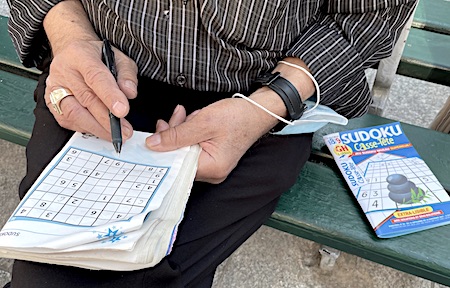
The sounding results of these investigations, speculations and experimentations, the origin of which goes back to 2006, will be laid down in five digital downloads at Bandcamp's, including two volumes that each contain a selection of 14 sudoku solutions picked from the set of the 52 2020-weekly tracks (volume 2, release-date: October 9th 2021; and volume 3, release-date: October 18th 2021). The first in the series (volume 1, release-date: September 27th 2021) is a collection of my earlier sudoku solutions recordings, all from 2006 or 2007. These three albums along with the final one (volume 5, release-date October 25th 2021) will become available for streaming and download this autumn on Bandcamp. The fourth album will have to wait until some later date, as that one is meant to bring you a recording of a performance of a sudokist string quartet, a composition based on the number series in all the sudoku's used in the recordings of the 28 tracks of volumes 2 and 3.
Volume 5 presents a different way to generate a sudokist composition from soduku solutions, a way that—to the 'deep listeners'—will by then already have become apparent as the aural canvas on which some of the 2020 sudoko solution recordings on volumes 2 and 3 were painted. On this fifth album, however the pieces are no mélange, they come straight, without chaser: this is pure 'Sudo, kiss me!', based on the 24 remaining of the 52 2020 weekly sudoku solutions, the ones that did not become part of my selection for vols. 2 and 3...
28 min read 🤓
The Art of K7 :: Südokaising
[ii] Time-Folds
september 11, 2021
« impose
a limit
on the infinite »
Mallarmé and a coup de dés
« l'unique nombre qui ne peut pas être un autre »
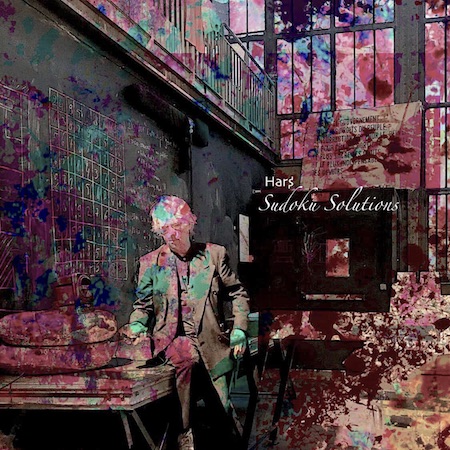
In the series Sudoku Solutions, I use the numbers sequences obtained from solutions of sudoku number puzzles as instructions (as scores) to perform intertwined pseudo-looping double cut-ups of a certain stretch of cassette tape (with recordings on both 'sides'). The double cut-ups hence are generated in a formal, procedural way, that brings echoes of (wink-wink) 20th century serialism to 21st century free dictaphonic improvisation.
It is why I call it: sudokism .
Sudokism transcends the very personal and subjective twitches of surprise, pain, indignation, joy, disgust, whatever, that the sounds on your tape might—and often do—evoke.
It is proper to free dictaphonic improvisation that sounds 'appearing' in the course of a performance often will be 'previously unknown' as much to the performer as they are to the hearer. Many of the tapes used moreover are filled with recordings covering episodes from a cassetteur's life, dating back way into his or her past. It is hard indeed not to think of Edison's 'ghost machine': such sounds over the years gain evermore in 'phantom-like quality'...
And suddenly he's back again! Your long dead father's speaking! Or there you go, tumbling one more time into that hole in the floor of a spooky Parisian underground car park... Sudokism avoids that as a performer you get caught in a web of private semantics, where you start (re-)acting (according) to a recording's 'subjective meaning' rather than to its 'objective sound'ness.
All this again in sort of a tongue-in-cheek-ish manner, mind you. It is the play that here we play. But it actually was a thing that profoundly haunted Pierre Schaeffer in his quest for a musique concrete. To him this felt as a major obstacle: that a (field) recording's 'semantics' messes up 'sonic pureness'; that what you get/hear when 'musicking' with 'real life sounds' (doing musique concrète), often ends up being more like a 'literature' than a music.
Haha, you can say: « OK, great. Tant pis... If you think it's literature, literature it be. What do I care how you call it, it's only rock'n'roll, and I like it... »
But Schaeffer cared, for he had set himself this goal of a total re-construction and transformation of the art and science of music ! (Frustrated in his days on top of all that by not being taken seriously by whole bunches of arrogant ('considering-themselves-to-be-real') composers. Cf. Pierre Boulez' haughty dismissal of Schaeffer's musique concrète as 'du bricolage'.)
So there you go.
This is here and this is about these things.
(Without any claim to truth, without dogma, all just speculation. And I love literature, haha 😏)
What sudokism does do, is allow for a scripted dictaphonic performance that gives you an excuse to disregard semantics. Hell, yes it forces you to! You can no longer wait for your dead father to finish his sentence, or for you to re-emerge from the hole into which you just tumbled.
You switch whenever the sudoku solution tells you to switch!
You see what I mean?
Haha, anyway, I think it's an interesting and plausible argument.
Just think about it.
Opting for a sudoku solution, the cassetteur does her thing the same way a traditional musician performs a piece of music from a score, her eyes scanning the notes, nerves beaming them straight down to her legs, arms, fingers... (Mind you, this does not necessarily mean 'routinely'!)
And to keep the automaton —and the music!— going, you... count!
Sudoku Solutions can be performed manually using a cassette player that is equipped with an auto-reverse switch. Preferably one that reacts smoothly and swiftly and can be held in the palm of one's hand. And the scores are, yes indeed: sudoku solutions. I did my first ones live on the evening of Good Friday 2006 (April 14th) when I met up with Rinus van Alebeek for a di-dictaphonic performance in 'De Nor', a cultural centre in the Dutch town of Heerlen. The early sudokist dictaphone pieces, all recorded in 2006 and 2007, now for the very first time will become available as the opening volume of my 'Sudoku Solutions' series on Bandcamp.
When at some point in time, due to excessive use and maltreatment, my favourite SONY TCM 500DV dictaphone broke down, for many years I no longer could perform Sudoko Solutions. I almost forgot about the little technique, until about two years ago, when WeiWei found me a second hand Aiwa 'Crosstrainer' SP370 walkman/radio in Taiwan, with an auto-reverse switch. Not as cool a tool as the SONY TCM 500DV (the Stradivarius among handheld K7 dictaphones 😏), but it was in mint condition, and the switch was a good one.
In order to celebrate, and profit from the Aiwa's A/B-switch before also this little machine would break down (as of course it eventually will), I decided to record one Sudoku Solution every week of the year 2020.
That also gave me an excuse and opportunity to look a bit closer at what is actually happening when you're sudokaising, and to play around a bit with the combinatorics that comes with sudoku grids.
You can read about that in my first 'Sudokaising' article on the SoundBlog, published in March 2020.
Random history
As source material for the 52 weekly 2020 Sudoku Solutions, most of the time I picked a cassette from my vast library of 'Sound Chronicles' (the audio cassette tapes that I have been filling with lo-fi fieldrecordings from my daily life, some going back to the mid-1970's, and running up to the early 2010's), and from my piles of boxes filled with found tapes.
Pretty early in the year I felt the need also to be able to use more recent recordings, ones that are digital and not on cassette. This had me write a short script in Ruby, that allows for doing Sudokaising using a 'virtual cassette tape' in the so very wonderful live coding tool Sonic Pi. (You can find the script and explanations of how it works a bit further on in this paper).
Scripted sudokaising however (and of course) robs one of the physical pleasure of handling oneself the switch button, and of the also very physical act of counting and tapping the sudokist beat...
I did not have any 'system' or masterplan for selecting the source cassettes and files. The picks were pretty much accidental and in the spur of the moment (not surprising, as I have to admit that there is little or no organisation that would help me to find some specific recording on one of those thousands of cassttes), so that the resulting collection of recordings in volumes 1, 2 and 3 also is a random walk through my 'Sound Chronicles' recording archive, spanning—almost— a half century of sound.
[ Except for the titles, the first three volumes all come with the same cover (see above). The original photograph was made by Yungwei Chen during a live sudokaising performance at La Générale Nord-Est, Paris, on September 29th, 2019. Analog colored layers were added digitally to that picture by Rafael González on the island of Tenerife, in the summer of 2021. ]
...
Time-folds
« De "sudoku solutions" zijn als vouwen in de tijd, verkreukelde blaadjes, verfrommelde momenten... »
Each "sudoku solution" is like a fold in time. It's a crumpled leaf on which once a story was written. But all you that get hold of and may look at now is this paper wad with but a couple of readable words, and a number of cut-up and broken phrases that you then are viewing again and again and again...
Let me, as an example, lead you through one of them in some detail. Take Sudoku202043, which is not part of the 28 tracks selected for the 'Sudoku Solution' albums, but which—because of its semantics— is included in No.284 of Stduio's anthology of 'awesome foursomes'.
This sudoku solution was scripted in Sonic Pi. It uses as its virtual tape a 50+ minutes mix by Drusz Kharg that includes digitisations of parts of analogue cassette tapes that FPCM recorded in the early 1980's, most probably some time in 1982. The mix's first half as the virtual tape's A-side, the second half is its B-side. From the A-side we hear parts of a recorded 1982 telephone conversation between FPCM and Jan Dietvorst, in which the two colleagues and friends exchange tips and tricks that will enable the blurring of screen print lithographies. (As music mixed in with the telephone conversation you can hear Carl Banks or Barry Beckett on organ with Jimmy Ray Jenkins and Albert Lowe on guitars, ready to back Etta James in I’d rather go blind.) On the virtual tape's 'back side', the Sudoku Solution strays in the midst of an 'ULTRA-electronicky' transition between mixed-in music tracks and 1982 telephone calls.
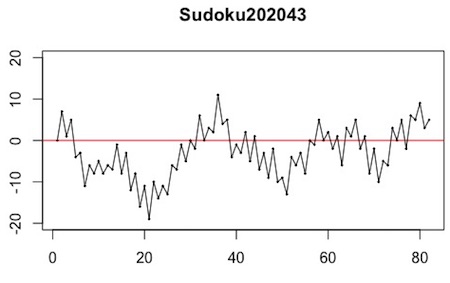
The 43rd Sudoku Solution [7,6,4,9,1,8,5,2,3, 3,2,1,6,7,5,9,4,8, 5,8,9,4,3,2,7,1,6, 4,5,2,8,6,3,1,9,7, 1,9,3,2,5,7,6,8,4, 6,7,8,1,4,9,2,3,5, 8,1,6,5,2,4,3,7,9, 2,4,7,3,9,6,8,5,1, 9,3,5,7,8,1,4,6,2] generates a string of pseudo-loops along a smallish stretch of the virtual tape, whose total length, measured in playback duration, is precisely 21 seconds. Cuts within these 21 seconds, on the A-side and on the B-side, are being mashed, repeated, mixed, skipped, according to the numbers of the sudoku solution. Read line by line from the left to the right, we keep stepping back and forth within a doubly folded, curled, bent, cockled, crackled, rippled, crimped & crumpled stretch of time, some of which was caught on tape almost forty years from here...
5 'Sudoku Solutions' albums
[1,2,3] :: the first three albums are sets of sudokaising recordings that make use of my library of 'sound chronicles', the majority performed on cassette, but a number were scripted using digital audio files as a 'virtual cassette tape'. The second and the third of these first three albums are the documentation and a wrap, say, of my last year's weekly sudoku solution recording routine.
[4] :: the fourth one, fo(u)rthcoming, will be a recording of the sudokist string quartet generated by the permutations of 1:9 contained in the 28 sudoku solutions that were used in the recordings on volumes 2 and 3.
[5] :: the fifth and final one—called "Sudo, Kiss Me!"—shows a different sudokist interpretation of these same 28 sudoku's, here resulting in a minimalistic electronic piece for 6 voices, played and recorded in Sonic Pi, and with a duration of exactly 4 × 81 minutes. Play this one at (very) low volume in a silent room...!
1. Volume 1 ~ 2006-2007
The first volume contains a selection of sudoku solution based recordings done on various occasions, but all probably in the years 2006 and 2007. I had put them aside for inclusion in a next volume of Sound Chronicles, mostly pop-song length collage-pieces built/composed using my large collection of cassette field recordings as sources, that for many years also provided the main source material for my live performances, in different settings and combinations, like that of Diktat. But that (third) volume never came about; for reasons that I am not sure about any longer myself, its finalisation was continuously postponed. All sudokaising on these volume 1 tracks was done with the SONY TCM 500DV dictaphone, that at some point (but that must have quite some years after 2007) broke down, removing sudokaising from available techniques for a couple of years (as explained in an earlier article).
For all volume 1 recordings the precise sudoku's used in their performance are unknown. Some indications on the where and what of each of the eleven pieces can be found in the info part of the tracks on the Bandcamp page. Almost all sounds were recorded onto cassette tape some time between the early 1980's and the early noughties; in Paris, Maastricht, Utrecht, Amsterdam, Berlin and elsewhere.
You'll hear snippets taken from the noisy business of lo-fi cityscapes, the bleating of sheep, the loud chattering of people gathered socially, snatches of music on record or played live, straight or glitched by failing playback mechanisms or tape-defects.
There's a friend reading in French, and my mother talking in Maastricht dialect about who to vote for in the Dutch general elections of 2006.
You will get an impression of what a Placard performance sounded like without your headphones on, and hear bits of output generated by one of Gottfried Michael Koenig's PR programs played back through the wonderful VOSIM sound synthesis system at the Utrecht Institute of Sonology, in 1983 or 1984.
There's sounds and musicians recorded in the Paris underground, K7 playback manipulation, a French bailiff (huissier) dictating his findings onto a dictaphone, and the muffled and far away sounds recorded at the beach of the île de Ré inside a plastic bag to protect the little microphone from fierce winds blowing, on the 14th of July 2007, just a day after I almost killed myself and my family falling asleep behing the wheel while driving on a French highway.
You hear women chatting in an Amsterdam tram, and a couple of Maastricht teenagers, nasty little guys hurling streams of xenophobic insults (in Dutch), aimed at foreigners and anyone of a different race (embarrassing and disturbing, because these must have been words, slogans, phrases that they picked up from the Maastricht adults in their family and neighborhood).
Time and their words keep folding back onto themselves, going round and round, building up presence in their insistent repetition.
Sometimes the sounds that keep spinning also to me remain unidentifiable, mechanical sounds, hissing, clickings, recorded some day some time some where, outside or inside, or in one or other mean of transport.
The first volume ends with a sudoku solution applied to one of the handful of sound chronicle cassettes containing recordings of the rants and fits of Carine (or Karien), a one time downstairs neighbour. This one here rant, folded and crumpled in time, for once is not a mere avalanche of cursing and insults (usually directed at me and my family), but rather a praise of Palestinian people. « Ce sont des gens nobles, » she shouts. « Ils ont du courage au moins, ils ont des couilles au cul ! »
2. Volume 2 ~ 2020.1
The sonic sources for the 28 tracks included on vols. 2 and 3 span several decades. Think of a razor-thin slice of the world as I found it, shredded into a thousand pieces. The shreds were thrown in a box and the box was thoroughly shaken. Then 28 pieces (imagine 28 narrow strips of paper) were randomly fished out of the box, and crumpled, one by one. And it is only then that you read what's still discernible.
Your read it again and again.
Some of the 'texts' are sort of 'abstract' (I mean that the sounds were not 'field recorded'), like the computer voice citing the formula of Whatever-World (nine permutations of the letters of our alphabet); or a cut-up of my Mosquitoes story, set during the first ever Stockhausen summer courses (in the German village of Kürten, in 1999), also read by a digital voice (Vicky).
Other pieces (mostly by mere chance) echo and touch upon events that had a profound impact. (Mainly) on my personal life and history. But some of them also on our world. The two are obviously related. And though the [direct] impact of my personal fates and fortunes on the faring of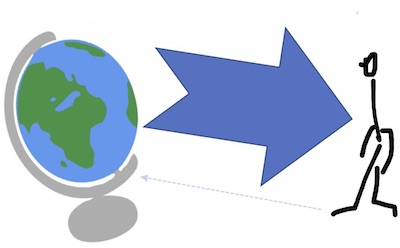 our world is pretty much zero, the same of course can not be said about the arrow pointing in the opposite direction.
our world is pretty much zero, the same of course can not be said about the arrow pointing in the opposite direction.
Around the turn of the milennium the world as we continued to find it, started evolving towards one deeply other than the one we found before. We're in a different world now. Precisely how different remains for next generations of writers and thinkers to determine and discuss. But it is utterly fascinating, that the deep differing that a great many had imagined the second of the thousands of years that our brand of mankind has counted to bring [as in some of the 'futures' so often articulated, imagined and expressed
You hear CNN reporters as they witness—totally flabbergasted—the collaps of the twin towers in the wake of the 9/11 attacks, one of the rare mainstream media news bytes that at the time I recorded
onto one of my chronique sonore cassettes ( * ).
On 9/11's sixth anniversary in 2007, I captured the slogans and noise of conspiracists manifesting in Manhattan in the streets around Ground Zero,
convinced as they were (and are) that 9/11 was an inside job.
It was in February 2001
that at the Parisian cemetery of Père Lachaise I attended the cremation of Iannis Xenakis. And almost seventeen years later I found myself in the small ceremonial hall of a tiny cemetery somewhere in an outskirt of my hometown Maastricht, where a few people had gathered for a last greeting to my mother.
There's the verse that Block Barley sampled from a beautiful song by Scott Fagan, a sample that looped in the B-boys' Tapemosphere installation, a wonderful cassette tapes & players sculpture that they were building when I visited them in Cologne (in the spring, again 2007); as long as I live, that loop to me will bring back the hurt felt in the very painful (were it months?) period in which my daughter (in a figurative but also very literal sense) « ne marchait plus » (she stopped walking, but the French is closer to what was really going on).
Many short and multiply folded bits of music emerge —almost always accidentally—from the archive of tapes that I recorded over the past fifty years. The earliest one here is from a Quirass recording, saved on one of two cassette tapes with the full recording of one of the pirate radio (WHS) shows that I did in Amsterdam in the early 1980s. I'm not sure of the Quirass recording's date, but my best guess is spring 1974.
Only one of the time-folds here echoes the current pandemic crisis: there is a lady announcer's pre-recorded message, diffused in the Parisian metro, pointing out to travellers that it is obligatory to wear a facemask. I recorded it on my iPhone, on May 10th last year.
3. Volume 3 ~ 2020.2
The earliest time-fold on volume 3 comes from a C60 cassette filled with recordings of me playing the upright piano at my mother's house in August 1981 (the one she learned to play on as a kid, a gift from her parents, an instrument that now, forty years later, I keep in a storage box not far from my home, where it awaits the sounding of its final untuned chords). The most recent one was scripted in Sonic Pi using a virtual cassette made from iPhone recordings that Yungwei made in Taipei during buddhist rituals in the weeks following May 1st 2021, the day that her grandfather died, rituals that prepared for his body's definite departure from the world of the living and his re-birth in a novel material form. Two other tracks take you to the street in Amsterdam-Oost, where I lived most of the 1980's. The recordings there were made in the summer of 1984, probably shortly after I read R. Murray Schafer's The Tuning of the World, and captured the sounds floating in from the street through the front windows and from the gardens through the back windows, hanging out the lapel microphone connected to my cassette dictaphone.
There's the ookoi late at night returning to their lodgings in Maastricht during the 2007 Kunsttour, struggling with
A couple of the 14 tracks on the third volume are marked by a series of glitches (wow, flutter) because of a faulty playback of the used cassette by the Aiwa player, due to either mechanical distortions of the tape's casing or to lubrication problems ( *** ), preventing a smooth transport of the tape by the player's little motor. No effort was made to remedy such mechanical problems, as I take the cassette tape and cassette player to be active participants in the sudokaising. The wow, flutter, clicks, hiss due to tape degradation and other wear is welcomed as part of the process. (Mechanical playback errors and tape errors are of course very notably absent in those tracks were the Sonic Pi script and a virtual tape were used to perform a sudoku solution).
Sudokism
There are many, many variations one may think up on the sudoku ( *+ ) theme. The appeal of the 9 by 9 grid is obviously that it allows for the use of exactly and no other than the 9 non-zero digits of our decimal system. Composers, on the other hand, might prefer a 12 by 12 grid, where each of the filled-in permutations denotes one of the entries in some given twelve tone series.
Though I do not have an example at hand, someone already must have used 12 × 12 sudoku grids as a basis for serial composition. Haha, if I were your composition professor, I surely would come up with that as a class assignment at some point.
First approach
I imagine then that, for example, you'll interpret the grid's columns as permutations of a twelve tone series', and for each of these columns (permutations of the original series) you then could use the corresponding row as the permutation of an initial series of twelve durations. In the example below, the green column will give us the permutation of the 12 tone series, the red row the durations of each of the twelve notes. So, in this example note 10 will receive duration 1, note 3 duration 7, note 8 duration 6, and so on.
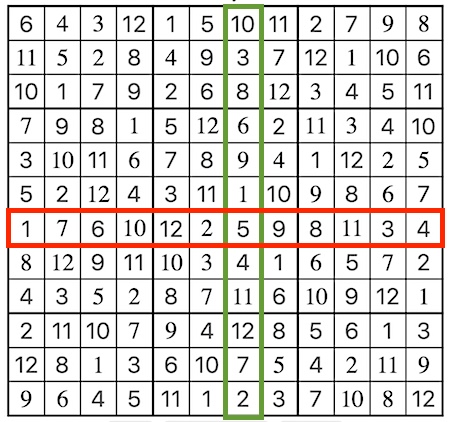
...
As no one has come to offer me a composition professorship yet, let me do the exercise myself. I want to stick, though, to the original 9 × 9 sudoko format. Therefore, instead of a twelve tone series, the composition (it will be a string quartet, called (just like last year's project and the corresponding releases of 2 × 14 selections from the 52 weekly sound files on Bandcamp: Sudoku Solutions) will make use of twelve nine tone scales. And yes, indeed, this may very well be the very first application in composition ... [ tension rises, drum roll... ] of ... :

4. Volume 4 ~ String Quartet
...
The variation 1 composition's skeleton will be given by the 28 sudoko solutions that I used in creating the 28 tracks that I selected from the 52 '2020'-solutions of yesteryear's 'weekly sudoko solution' project to together make two digital download CD's at Bandcamp.
Grouped in fours (for the four instruments of a string quartet), that makes 7 × 4 sudoku solutions; and each of the seven groups will, as a basis, be assigned one of the seven 'white note' nine tone scales: A, B, C, D, E, F and G. For the nine durations, taking 1/16 as the 'one', the scale of nine durations is given by 1 followed by the first eight primes, i.e. {1,2,3,5,7,11,13,17,19} × 1/16.
But that of course is but the first step. It's where the real composing starts, and where I will also put the permutations of a sudoku solution's boxes to good use. (The boxes are what distinguishes a sudoku solution from a 9 × 9 latin square. Let me clarify also that even though all of this 'play' is inspired by sudoku's, it can all also be done using whatever way a 9 × 9 grid has been filled with the numerals 1 to 9... The execution in all cases will be similar.)
Second approach
This is actually my preferred one, and less of a take on 20th century serialism. It, arguably, stays closer to cassette sudokaising as a zig-zag but not random walk, more of a drunkard's stagger, along a stretch of analogue audio tape, interprets the numbers in the columns of the sudoku-grid not as notes in a scale, but as intervals, taking you alternately up and down that number of half-notes, starting from some chosen base note. The rows, as before, will be interpreted as series of duration.
My variation 2 composition's skeleton is given by the 24 remaining sudoko solutions, the ones that did not make it to the selection of volumes 2 and 3.
Grouped in sixes (for six identical instruments that can play relatively long durations), that makes 4 × 6 sudoku solutions. The (un-sounding) chord with which this sudokist variation starts is the cluster D(4)#-E-F-F#-G-G#.
Other than in the case of the string quartet, from this and chosing the durations to simply stand for the 'number of ticks' (one tick = 1 quarter note), to be played 'very slowly', pretty much all needed to write down this varation 2 sudokist composition, has been fixed.
5. Volume 5 ~ "Sudo, Kiss Me!"
The 'pure sound' version that will be released as volume 5, "Sudo, Kiss Me!", was scripted in Sonic Pi. The 24 sudoku solutions were taken in a random order, and then played back and recorded in groups of six, with a 'tick'-length of 12, which (at the default Sonic Pi bpm of 60) makes that each of the four parts will lasts precisely 81 minutes (the number of cells in a sudoku grid).
The following are representations ('graphic scores') of each of the four parts (the graphs were drawn in R). The pics nicely show the wandering of the six voices (each voice is the coloured graph of the staircase pitch~duration function defined by one of the six sudokus) in each of the parts. Note that the 88 notes on a standard piano keyboard go from A0 (MIDI note 21) up to C8 (MIDI note 108); indeed, some of the voices run way beyond that range.
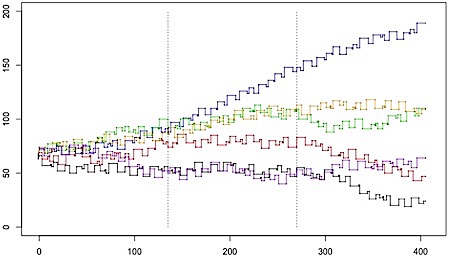
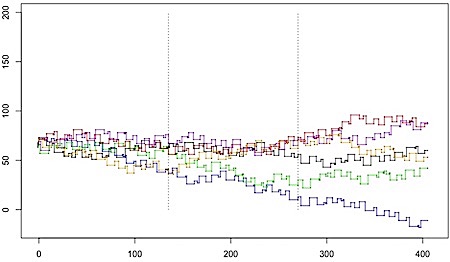
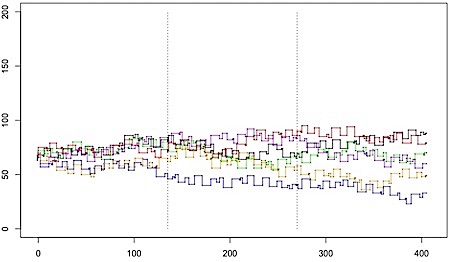
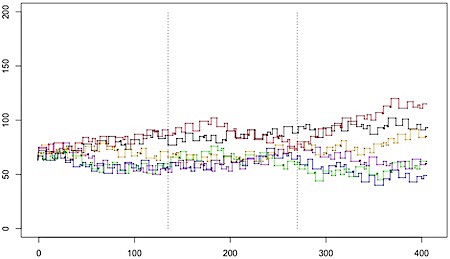
One can imagine a sudokist composer looking for sudokus which exhibit certain patterns of wandering, and then combine those.
It is also easy to transpose a voice. Just change the corresponding line's starting note in the (un-sounding) initial chord.
AND HERE'S THE VERY SPECIAL OFFER THAT COMES WITH "SUDO, KISS ME!"

😎
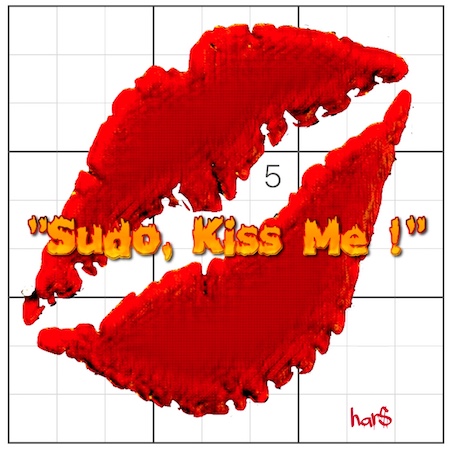
...
...
The art of switching sides
Not long after I finished writing the first part of these reflections on the act and art of live-switching sides of a K7 (by means of the auto-reverse button that used to be part of the controls of some cassette players and handheld walkman/dictaphones), in a 'mechanical' way, i.e. other than a 'switching by ear', switching sides whenever the sound, the 'feel' of/& your intuition tell you to—which some might consider to be the truly 'musical' way, haha, and which indeed is precisely the 'thing' that I sought to transcend—I set myself to simulating these sound playback processes with digital files. Which I guess could be done on pretty much any of the multitude of available platforms for sound manipulation. I did it using Sonic Pi (meaning that the scripting language used is Ruby), but the (algorithmic) principle of course will work pretty much anywhere.
Here is that script, with comments that'll make it pretty much speak for itself, once you understood how the 'switching sides' works. To make for a 'literal' simulation of the K7-switching, the two sound files should be (thought of as) digitisations of the two sides of an audio cassette tape, in particular they would be of the same length.
# ========================================= #
# SUDOKU K7 multi-cutup simulation script #
# Har$ <> April 4th-11th, 2020 #
# [added random tick length deviation #
# July 25th, 2021] #
# ========================================= #
# Load the two sudoku files (A-side / B-side)
Aside = "[path to your A-side file]... /ritual_A.wav"
Bside = "[path to your B-side file]... /ritual_B.wav"
# Sudoku 202045
sud = [9,6,2,4,3,7,5,8,1,
5,3,1,2,8,6,9,4,7,
4,7,8,5,1,9,6,3,2,
8,9,7,6,4,1,3,2,5,
1,2,6,3,9,5,8,7,4,
3,5,4,7,2,8,1,6,9,
7,1,9,8,6,2,4,5,3,
6,4,5,1,7,3,2,9,8,
2,8,3,9,5,4,7,1,6]
# set length of loop (for a standard sudoku it is 40)
length=40
# counter for loop
c = 0
# playback duration per counting unit equal to 1 second
time_fact = 1/(sample_duration Aside)
# multiply time_fact by factor smaller/bigger than 1
# to increase/decrease counting unit duration (tempo)
incr = 0.7
time_fact = incr*time_fact
#
# pick starting point of play; 0.5 is middle of sample
Afro = 0.21
# get random seed from now-time for random deviations
# in tempo of epoch play (sway)
time = Time.new
use_random_seed time.usec
#
# Do 40 x 'A-then-switch-to-B'-play
#
length.times do
# A-side epoch play
# random deviation of tick length (sway)
sway = rrand(9,11)/10
# for metronomically precise tick length: put sway = 1
# sway = 1
Ato = Afro + sway*time_fact*sud[c]
sample Aside, start: Afro, finish: Ato
sleep sample_duration(Aside, start: Afro, finish: Ato)
# B-side epoch play
Bfro = 1-Ato
# random deviation of tick length (sway)
sway = rrand(9,11)/10
# for metronomically precise tick length: put sway = 1
# sway = 1
Bto = Bfro + sway*time_fact*sud[c+1]
sample Bside, start: Bfro, finish: Bto
sleep sample_duration(Bside, start: Bfro, finish: Bto)
Afro = 1-Bto
c=c+2
end
#
# final epoch play
# random deviation of tick length (sway)
sway = rrand(9,11)/10
# for metronomically precise tick length: put sway = 1
# sway = 1
Ato = Afro + sway*time_fact*sud[c]
sample Aside, start: Afro, finish: Ato
It is easy to adapt the above to make it switch-play two sound files (like it were a 'two sided' tape) according to any other given sequence of durations; or make it switch-play two such "back-to-back" sound files according to a given sequence of durations with random switching of sides (sometimes you switch, sometimes you don't); or make it switch-play the two sound files according to a random sequence of durations, with or without random switching of sides; and so on and so furthur [sic], I am sure you can think up yourself quite a few more variations on this switching theme...
What of course will remain out of reach of all these sort of scripts (for that would take a far more sophisticated approach) is a side switching triggered by audio cues, that is: by listening to what is being played... Maybe a neural net could learn a player's switching habits; if it did, that would almost mean it'd learned how you listen (though maybe not quite yet what you hear, haha).
—(maybe) to be continued—
notes __ ::
(*) That particular track therefore with a big arc appears to pointing back to a track on my Sound Chronicles album: MyCNN. [
^ ]
(**) The name 'Sudoku' under which the number game became known worldwide and highly popular [a 'shortening of [the Japanese] Suuji wa dokushin ni kagiru ("numbers should be single")', says wikipedia], was given to it by Japanese entrepreneur Maki Kaji (1951-2021). [
^ ]
(***) Tape is covered with a thin film of lubricator that helps the transport. Over the years this substance may evaporate or dry out. [
^ ]
Read all about Sudokism and Südokaising on the SoundBlog:
(2025, april 18) - A decom-.pomdipem~padopi~dompadé.-posed suso
(2025, march 01) - Full coloration set sudoku solution pieces
(2025, january 23) - ‘War drift’ for violoncello, and other sudoku, latin and costas grids
(2025, january 3) - “Let me show you exactly what you are” (Sudoku 3, for double bass)
(2024, july) - Uit de kast: "I am a Sudokist!"
(2021, september 11) - The Art of K7 :: Südokaising [ii] Time Folds
(2020, march 21) - The Art of K7 :: Südokaising [i]
(2006, april 17-25) - 'sudoku-solution' in 'de nor'
Read about Sudokism and Südokaising on Medium:
(2024, october) - Variations on a Sudoku Solution for Perished Piano
Read all about Found Tapes, Foundtaping and Audio Cassettes (K7s) on the SoundBlog:
(2023, september 21) - Holland[s] Spoor
(2022, january 11) - 'The Art of K7', vol. 1
(2021, september 11) - The Art of K7 :: Sudokaising [ii] Time Folds
(2020, march 21) - The Art of K7 :: Sudokaising [i]
(2019, november 17) - Foundtapers & Foundtaping in Porto
(2019, februay 08) - CCNL :: Cassette Culture in Linz, Austria
[ii] The aesthetics of erasure
(2019, januay 18) - CCNL :: Cassette Culture in Linz, Austria
[i] Oral history
(2015, november 22) - Situasonnisme: the City Sonic Festival
(2014, june 19) - Lecture de Cassette
(2013, october 25) - The Art of K7 (prelude) [sketch/book, 1]
(2013, march 23) - "Ma première cassette était vierge..." Mourning & celebrating 50 years of compact cassette
(2012, july 26) - UnOfficial Release
(2010, november 28) - Foundtaping, Maps & Shadows
at the Basel Shift Festival (i.)
(2009, november 15) - prof. dr. Cassette
(2009, november 08) - A found tapes meta-map
(2009, october 22) - Founded Tapapes
(2009, september 20) - Found Lost Sound
(2009, july 26) - "You, a bed, the sea ..." [ 1. Athens, sept. 28th 1994 ]
(2009, may 23) - It feels like summer in the city [KT2009, i]
(2009, february 19) - Time and the weather - "? Footage or Fetish" @ Käämer 12, Brussels (ii)
(2009, january 30) - A Tingel Tangle Tape Machine - "? Footage or Fetish" @ Käämer 12, Brussels (i)
(2009, january 15) - Kassettenkopf
(2008, december 08) - un-Tuned City (foundtaping in Neukölln)
(2008, september 14) - Psycho/Geo/Conflux in Brooklyn, NY __i.
(2008, august 31) - " Le chasseur " (foundtaping in brussels_ii)
(2008, june 18) - "Sing Laping, Sing !" (foundtaping in brussels_ i)
(2008, january 06) - Mo' Better Mo-Tapemosphere, 2. Restmuell
(2007, june 16) - Mo' Better Mo-Tapemosphere, 1. "chase away all my fear"
(2007, march 07) - Back to Berlin 2. Found Tapes
(2006, september 28) - jenny likes poets
(2006, september 06) - the sound of almost-no-more words
(2006, june 13) - fotex #49-51
(2006, june 04) - Sonofakunsttoer
(2006, april 17-25) - 'sudoku-solution' in 'de nor'
(2006, january 19) - ride, buggy, ride ... !
(2006, january 13) - axiologie for dummies
(2005, november 06) - found in maastricht
(2005, august 28) - tête-de-tettine / tête-de-cassette
(2005, august 23) - tape busters and coordinates
(2005, july 02) - Conquering America ...
(2005, june 03) - stationed soother
(2005, april 21) - Low-fi : the new Readymades
(2005, march 24) - d_Revolution #1 ...
(2005, february 07) - found tapes for spies
(2005, january 28) - "parfois l'amour tourne à l'obsession ..."
(2004, november 06) - à la tranquilité
(2004, july 20) - instructions in arabic
(2004, may 08) - phound stufphs
(2003, august 04) - new acquisitions #7, #8
(2003, may 04) - r2r
(2003, april 24) - splice and tape
(2003, april 15) - new acquisitions #5,#6
(2003, january 09) - finders keepers
(2002, november 24) - exhibit #4
(2002, november 08) - what fascinates me
(2002, november 07) - more on found tape montage
(2002, september 14) - detour
(2002, september 09) - 2 down, 3 to go
(2002, september 06) - magnetic migration
Read about Found Tapes in Gonzo (Circus) [Dutch]:
Gonzo #163, mei/juni 2021 - Lang Leve Lou Ottens
Gonzo #137, januari/februari 2017 - Het Kaf en het Koren
tags: k7, sudoku, sudokism
# .513.